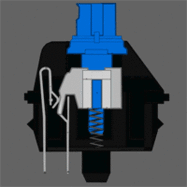Clicky
| This article requires illustration in the form of diagrams — most designs need diagrams to indicate how the mechanisms described actually generate a click |
Clicky refers to a keyswitch with a dedicated clicker mechanism. A clicky keyboard is one which uses clicky switches.
When depressed, a clicky switch omits a click sound in conjunction with actuation. This sound is distinct from the clack sound when a key is bottomed out. Clicky switches typically actuate at mid-travel, which means that depressing a click switch slowly will trigger a click sound before the key is fully depressed.
Some switches will inherently click when released. Many will only click when depressed, and make no additional sound when released. Some switch types will always click when depressed, and sometimes click when released, with this behaviour varying from key to key across the keyboard.
Various approaches have been taken to accomplish a click; most methods do not guarantee that the switch will click precisely when it actuates. One switch which does make this guarantee is the buckling spring, as the spring itself generates the sound when it buckles.
Contents
Mechanisms
Buckling spring
Buckling springs emit a click when the switch buckles and strikes the inside of the switch barrel. This is the only mechanical design where the actuation and click sound directly correlate.
- Bucklingspring-animation-300ms.gif
How actuation works
Click leaf
Click leaves are the most widely-used design. A folded leaf spring is pulled forward and released by the slider, and the click is emitted when the leaf spring snaps back and collides with the inside of the shell. Possibly introduced by Alps with the Alps SKCL/SKCM series, it has been widely copied.
Alps SKBM Grey with click leaf in position
Click arm
In what may be a unique design, Hi-Tek Series 725 switches use an arm similar to that in a latching action switch, which provides the click and tactility.
Sliding collar
Clicky Cherry MX switches use a sliding collar around the slider that is fired downwards to emit a click, and pulled back up when the key is released. This design has been copied by Cherry MX clones.
Click bar
This is a straight piece of spring metal placed across the switch, formed from one end of a short helical spring. The slider pushes the bar aside, and after it clears the bar, the bar springs back and strikes the inside of the case. Because the slider has to push the bar aside on the upstroke also, this method provides identical press and release clicks.
Currently this is known from Kailh PG1350 and PG1511 series.
Simulated click
Some keyboards that do not have clicky key switches can emit a "click" sound on key actuation either using a built-in speaker, a dedicated clicker or through the operating system.
- The Kinesis Advantage has a speaker and the click sound is optional.
- IBM Beam Spring keyboards have both clicky switches and typically also a dedicated solenoid to provide click. Some models had speakers.
- Many touch-screen keyboards provide click sound on key actuation, often as the only feedback.
- ClicKey is a freeware program for MS Windows that plays a sound on each key press.
eBay controversy
On the auction site eBay, rulings have been made in favour of sellers that have described keyboards as "clicky" when the item for sale had not been. The administrators on eBay have erroneously ruled "clicky" to be a subjective term. [1]
See also
References
- ↑ Geekhack thread: Beware of buying keyboards on eBay. Retrieved 2013-09-12










